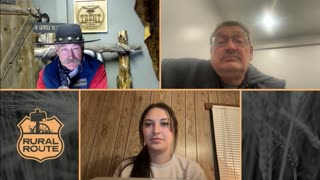Premium Only Content

Total solar eclipse: Where and when it was most visible on April 8th 2024
ECLIPSE MERCH AVAILABLE: https://totaleclipse2024.curatedspot.com/products/bestsellingshirts
The total solar eclipse that swept across Mexico, the United States and Canada has completed its journey over continental North America.
Last to see the dramatic celestial spectacle were sky-gazers located along the Atlantic coast of Newfoundland, Canada, at 5:16 p.m. local time 3:46 p.m. ET
Mazatlan, on Mexico’s Pacific Coast, became the first city to experience totality earlier on Monday. The total eclipse then darkened the skies over Texas, where spectators caught glimpses of stunning views, despite cloudy weather. Next up were the cities and towns in the midwestern US, with Indianapolis and Cleveland among the places viewers experienced the thrill of the celestial event.
Those squarely along the center line of the path of totality saw an eclipse that lasted between 3 ½ and 4 minutes, according to NASA.
In the US, an estimated 32 million people live within the path of totality and a total solar eclipse was visible for those in Texas, Oklahoma, Arkansas, Missouri, Illinois, Kentucky, Indiana, Ohio, Pennsylvania, New York, Vermont, New Hampshire and Maine, although weather threatened to spoil the fun for some.
Only a few isolated clouds were expected in Vermont through Maine, as well as Missouri through southern Indiana, making for optimal eclipse viewing. However, much of Texas and the eastern Great Lakes were issued warnings for less than ideal weather. A partial solar eclipse, where the moon appears to take a crescent-shaped “bite” out of the sun, was visible for those outside the path of totality.
One eclipse viewer, Richard Canedo, who has been a Planetary Society member since 1981, used the cloudy skies in Fredericksburg, Texas, to his advantage — he used the overcast conditions as a makeshift filter to capture the moment of total eclipse on his handheld camera.
As the fully eclipsed sun peeked through clouds in Fredericksburg, Texas, more than four minutes of total darkness was observed by the crowd of hundreds gathered that let out loud cheers and cries of, “Oh my God!”
At one point, the stunning, blazing ring visible during totality even showed off what Planetary Society CEO Bill Nye called a possible prominence.
“It’s magical everyone,” said Nye from the Texas outdoor stage event. “I am just so happy to be sharing this with you all.”
A crowd of thousands also gathered at the only NASA facility that was within the eclipse’s path of totality: NASA Glenn Research Center in Cleveland. NASA Administrator Bill Nelson, US Deputy Secretary of Commerce Don Graves, NASA astronaut Steve Bowen, San Francisco 49ers quarterback Josh Dobbs and even Snoopy made an appearance, all outfitted in eclipse glasses.
Special eclipse moments:
While totality is considered to be the most exciting part of a total solar eclipse, there were other special phases to watch for before the big moment arrived.
While totality is considered to be the most exciting part of a total solar eclipse, there were other special phases to watch for before the big moment arrived.
Apart from the weeks and months of anticipation leading up to the eclipse, the longest phase of the event was the partial eclipse, as the moon slowly moved over the sun. This phase lasted from 70 to 80 minutes.
But a great cue for spectators was when the skies started to darken and turn an eerie gray color, about 15 to 20 minutes before totality.
Then, several phases happened in quick succession just before the sun’s light completely disappeared from view.
Apart from the weeks and months of anticipation leading up to the eclipse, the longest phase of the event was the partial eclipse, as the moon slowly moved over the sun. This phase lasted from 70 to 80 minutes.
But a great cue for spectators was when the skies started to darken and turn an eerie gray color, about 15 to 20 minutes before totality.
Then, several phases happened in quick succession just before the sun’s light completely disappeared from view.
Sky-gazers observed drops of sunlight forming around the moon, known as Baily’s beads, as sunlight streamed over the craters and valleys of the lunar surface. After about 30 seconds to a minute, some of those drops appeared to merge together, creating a glistening “diamond ring” effect about a minute before totality.
During totality, the luminous glow belonging to the sun’s corona, or hot outer atmosphere, and its faint light is only visible when the sun’s ultrabright surface is blocked.
While totality is the main event, a few dots of light were also visible in the sky near the eclipse, belonging to Jupiter, Venus, Mars and the faint light from Saturn.
When will the next eclipse occur?
It’s a bit of a wait for the next celestial spectacle like this in the United States.
Those living in Alaska will catch a glimpse of a total solar eclipse on March 30, 2033, and a partial solar eclipse will shine over most of the US during that event.
A total solar eclipse won’t be visible again from the contiguous US until August 22, 2044, but totality will only occur over North Dakota and Montana, plus northern Canada.
The next total solar eclipse with a coast-to-coast path spanning the Lower 48 states will occur on August 12, 2045. The path of totality will arc over California, Nevada, Utah, Colorado, Kansas, Oklahoma, Arkansas, Mississippi, Alabama and Florida, with a partial eclipse visible across other states.
ECLIPSE MERCH AVAILABLE: https://totaleclipse2024.curatedspot.com/products/bestsellingshirts
-
 LIVE
LIVE
Graham Allen
1 hour agoSCARY: Kamala Had MELT DOWN Over Trump!! Does LSU Hate Charlie Kirk?! + Top Halloween Movies Of ALL TIME!!
16,809 watching -
 LIVE
LIVE
Wendy Bell Radio
4 hours agoAmerica Deserves Better
6,585 watching -
 1:10:29
1:10:29
Chad Prather
13 hours agoStanding Holy in a Hostile World
32.5K11 -
 LIVE
LIVE
LFA TV
12 hours agoLIVE & BREAKING NEWS! | FRIDAY 10/31/25
2,748 watching -
 1:04:43
1:04:43
Crypto Power Hour
12 hours ago $5.83 earnedCrypto Price Swings Explained — What Every Investor Needs to Know
31.7K7 -
 21:31
21:31
Clownfish TV
22 hours agoOG YouTube is Officially ENDING! Employees Offered BUYOUTS?! | Clownfish TV
13.5K25 -
 5:54
5:54
Gun Owners Of America
19 hours agoThe Virginia Election Could Shift The Balance of Power Nationwide
20.6K5 -
 2:00:02
2:00:02
BEK TV
1 day agoTrent Loos in the Morning - 10/31/2025
15.7K1 -
 LIVE
LIVE
The Bubba Army
23 hours agoIs Killing The New Trend??! - Bubba the Love Sponge® Show | 10/31/25
1,240 watching -
 2:25:16
2:25:16
Demons Row
14 hours ago $4.31 earnedEx Hells Angels MC President: Charles “Peewee”Goldsmith (Full Interview)
22.4K4